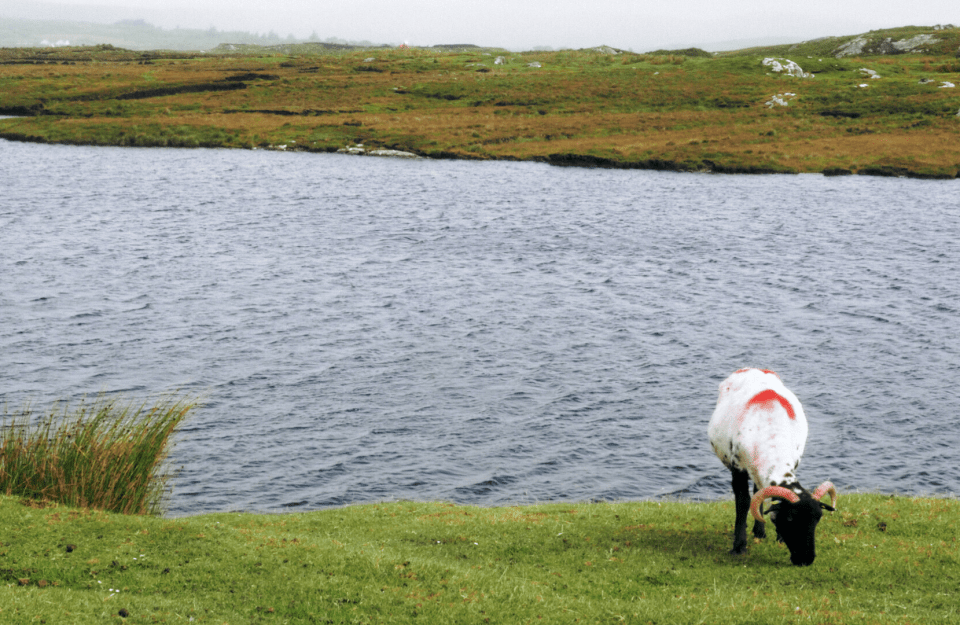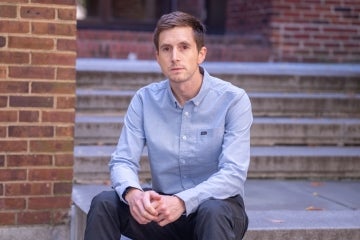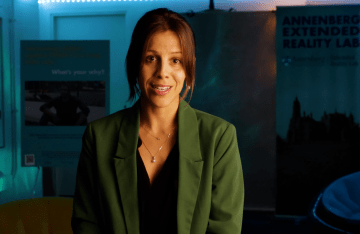A Scholar Who Listens
Recent postdoctoral fellow Matt Parker is recording the noises of our electromagnetic infrastructure in order to reveal the entanglements between networks, landscape, science, culture, and memory.

A still from Matt Parker's film "Do Sheep Dream of Electric Ruins?"
From grazing sheep in Irish bogs to the infrastructural hum of parks in Philadelphia, recent Annenberg Gilbert Seldes Multimodal Postdoctoral Fellow Matt Parker is here to listen.
An artist and a scholar, Parker has a poetic way of describing these landscapes, to which he brings field recording equipment to capture audio from things like powerlines and lightning strikes. He calls the Derrigimlaghbog in Ireland, the subject of his new short film “Do Sheep Dream of Electric Ruins?,” “a place of whispers and echoes where the land remembers everything.” He describes the electromagnetic energies of Clark Park in West Philadelphia as a “sensorial body.” He brings forth these descriptions through the practice of listening, capturing the magnetic fields that surround us, infrastructurally and planetarily.
Parker’s passion for listening began during his time as a musician. While touring internationally with his former band Nedry, he became drawn to integrating field recording into his compositions. This interest gradually evolved into a core focus of his practice, leading to the development of a sound arts research approach he calls “critical wavefield exploration.”

Since then, Parker has created a wide range of audiovisual and media works, including films, installations, and radio commissions, exhibited and broadcast globally across galleries, festivals, and media platforms.
In his academic work, his field recordings, and his experimental filmmaking, Parker explores memories, landscapes, networks, science, and sound, bridging together different modes of creativity and scholarship to capture “the resonances between things.”
Infrastructurally, Parker is interested in the resonances between environments, technologies, and history. His recent short film, selected to screen at the 2025 Society for Visual Anthropology Film and Media Festival in conjunction with the annual meeting of the American Anthropological Association, is a speculative documentary about the past, present, and future of electromagnetic infrastructures. The film and its accompanying journal article explore the remnants of the world's first commercial transatlantic radio-telegraph service, established by Guglielmo Marconi at the Derrigimlagh bog, which bridged continents through electromagnetic transmission.
A work of multimodal scholarship, the project demonstrates how infrastructural ruins, while obsolete, persist — and how these ruins can be used to study the fragility of the technological systems we use today. As part of this argument, Parker captured the sounds he experienced at the bog: water, wind, sheep — but also still, metal pipes and the noise of fence posts.
“This project began as a fascination with the ruins themselves: the rusting remnants of industrial megastructures, the overgrown pathways, the faint outlines of where masts once stood,” Parker said about the film. “But as I spent time on the bog, I realized the sheep weren’t just passive observers — they were actively rewriting the land. Their movements, their grazing, even their indifference, became a central metaphor for the resilience of the nonhuman world amid the collapse of human-made systems.”
At Annenberg, he taught an undergraduate class in spring 2025 that took students on a tour of an electronic waste processing facility in Grays Ferry to see firsthand the relationship between technologies and the environment. With co-instructor and fellow postdoctoral fellow Ennuri Jo, he also guided students around Penn’s campus on a mission to identify the unseen internet infrastructures that surround us daily.
Parker, who will be starting in January 2026 as Assistant Professor in Communication Studies at the University of Nottingham in Ningbo, China, recently made a journey outside of Philadelphia to the mountains of West Virginia. His destination? The National Radio Quiet Zone, a place free of electromagnetic infrastructures. (The land restricts radio transmissions so that scientific and military facilities can operate without interference.) There, Parker, equipped with his VLF (Very Low Frequency) receiver, listened to the sonic energies of lightning strikes around him, capturing the sounds of our planet, rather than the hum of technology. He described it as a “humbling experience.”
“I think that’s what natural radio listening does: it connects you in a really direct, visceral way to the planetary scale of our environment,” he said on the BBC radio production “All Under One Magnetosphere,” which covered his acts of listening in both Clark Park, Philadelphia, and West Virginia.
“Sound studies is the research of attention,” Parker said. “It asks who gets heard, what gets hidden, and how listening — across acoustic, vibratory, and electromagnetic registers — can remake how we know, design, and live with infrastructures and how, through this, we can be attentive to others.”
With the sound of sheep grazing or the buzz of Wi-Fi, Parker is working to reveal our entangled relationship with the planet, both its past and its future. He’s also encouraging us, in a world of unheard noise, to be good listeners.



